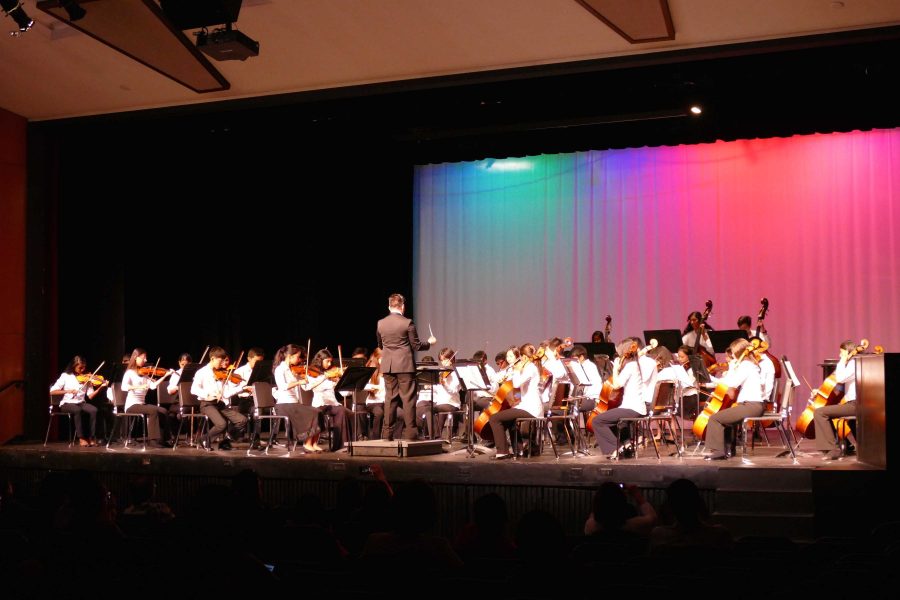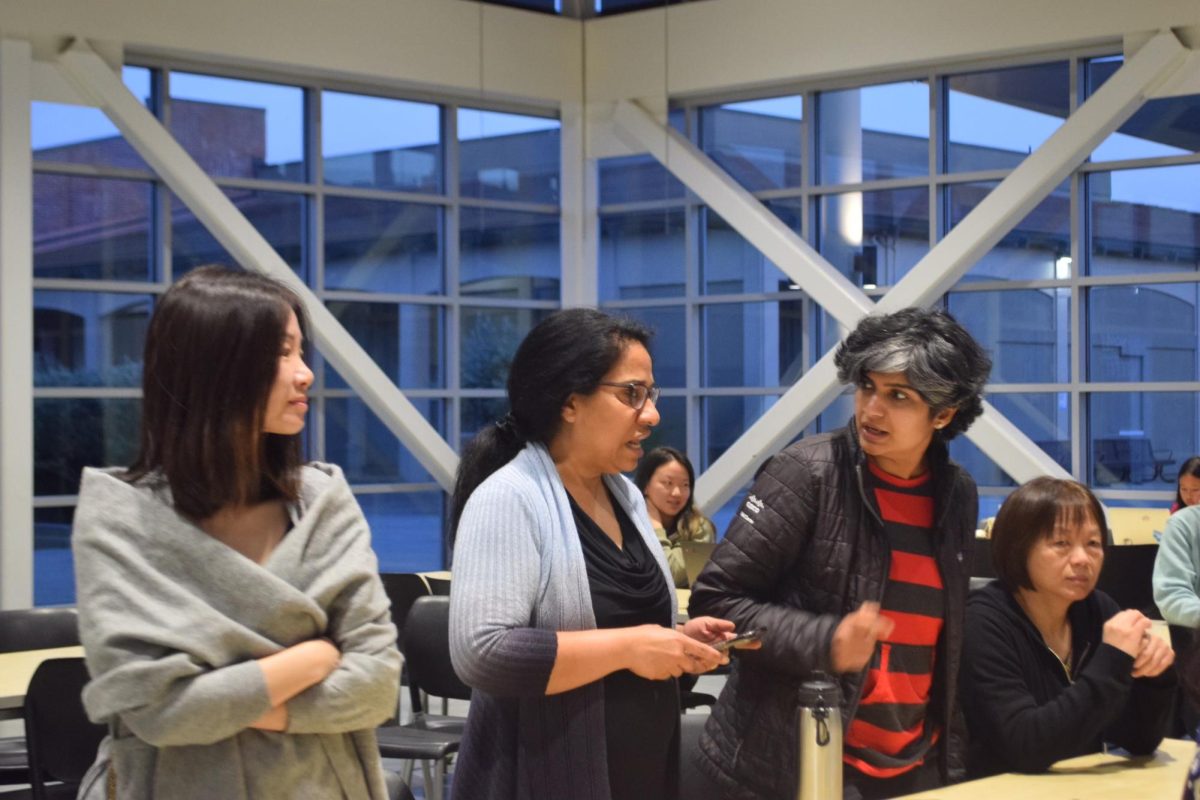The auditorium is quiet with anxiety and excitement as parents prepare their cameras and phones to capture the display of seven weeks of hard work. The first violinist stands up, raises her bow and brings it across the A string on her violin as the rest of the orchestra follows her lead. The performers take their seats and wait. A minute passes, and the orchestra whispers in confusion at the unintentional absence of their director.
“You can go ahead with the lights now,” a voice calls out from behind the stage.
The crowd’s laughter immediately turns into a surprised gasp as a spectrum of green, blue and pink light illuminates the stage behind the performers. The concert begins.
The preparation
While parents and students witness the beautiful end result on stage, the preparation process is what really brings it together. From the beginning of the school year, Chamber and String Orchestra have been preparing for their debut concert.

String Orchestra is composed of mainly freshmen and sophomores, while Chamber Orchestra is an elite group of strings players, most of whom take private lessons outside of school. According to String and Chamber Orchestra teacher Ricky Alegria, Chamber Orchestra moves at a faster pace and requires a more difficult repertoire. String orchestra is a way for students to gain the basic skills necessary to be successful in the future.
“We’ve been putting in close to seven weeks of hard work, and those seven weeks go by really quickly,” Alegria said. “I’m really excited to see what the end product sounds like based on where we started.”
Students who took orchestra last year had to adjust to Alegria’s teaching style, who joined MVHS in March, while dealing with the absence of their previous teacher. Junior Carol Wang, who is currently a part of Chamber Orchestra, was excited to finally perform all of the music. In class, students sight read the music, practice and refine parts that need more work, and have sectionals where individual sections focus on their own problems.
“This year has definitely been different as different teachers have different teaching styles, but overall I’d say we had a pretty successful preparation process,” Wang said.
Senior Janani Srindhar in Chamber Orchestra was especially enthusiastic for this performance since it was her first as a senior.
“It’s our last year of orchestra, probably my last year of music,” Srindhar said. “It’s kinda sad but it’s also exciting to think that we’re the big people on stage.”
Freshman Akhil Parvathaneni from String Orchestra regarded the debut concert as an exhilarating first performance.
“We’ve been practicing hard every day,” Parvathaneni said, “I’m excited to play the pieces that we’ve worked so hard for.
The performance
With almost all of the seats filled in the MVHS Performing Arts center, the concert began with String Orchestra. The first song was Finale from Fidelo, an opera composed by Ludwig van Beethoven during the Classical Era. An arrangement from Sandra Dackow brings together all elements of the orchestra, and provides an inviting and patriotic tune.
The next two pieces that followed were On a Shaker Hymn and Theme and Variations on “Twinkle, Twinkle”. Both provided a contrasting tone and ambience as they led up to the final piece, Fiddle Tunes No. 3. Before the piece was performed, Alegria told the audience to imagine fall weather complete with apple picking, spending time in a pumpkin patch and hayrides. Laughter spread throughout the room, and the piece began.
[soundcloud url=”https://api.soundcloud.com/tracks/227824130″ params=”color=ff5500&auto_play=false&hide_related=false&show_comments=true&show_user=true&show_reposts=false” width=”100%” height=”166″ iframe=”true” /]
After a brief intermission, Chamber Orchestra took the stage,
[soundcloud url=”https://api.soundcloud.com/tracks/227824491″ params=”color=ff5500&auto_play=false&hide_related=false&show_comments=true&show_user=true&show_reposts=false” width=”100%” height=”166″ iframe=”true” /]

starting out with a lighthearted classical composition by Joseph Haydn, titled Divertimento in D. What followed was a heavier and darker piece by Giacomo Puccini, deemed a favorite amongst Chamber Orchestra students. The melancholy tone and minor key was meant to reflect the death of Duke Amedeo of Savoy.
Next came a three-movement piece by Wolfgang Amadeus Mozart. Divertimento No. 3 in F captured the essence of music during the Classical Era, and brought light hearted and refined expression to the audience.
[soundcloud url=”https://api.soundcloud.com/tracks/227820401″ params=”color=ff5500&auto_play=false&hide_related=false&show_comments=true&show_user=true&show_reposts=false” width=”100%” height=”166″ iframe=”true” /]
The Chamber Orchestra closed the performance with Rosamunde, a romantic piece by Franz Schubert. The final note was played, and a wave of applause filled the room. The orchestra stood tall, with smiles on their faces. It was the end to a successful performance, but the beginning of a promising year for String and Chamber orchestra.
[soundcloud url=”https://api.soundcloud.com/tracks/227823286″ params=”color=ff5500&auto_play=false&hide_related=false&show_comments=true&show_user=true&show_reposts=false” width=”100%” height=”166″ iframe=”true” /]
















